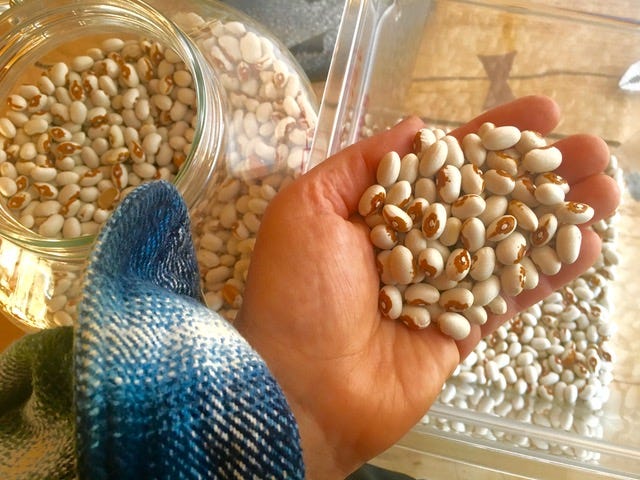Today’s guest post is by
, a full-time farmer, gatherer, and fermentation educator living on a 1,300-acre mountain farm in Vermont. She makes koji-based ferments from the wild and cultivated abundance around her. Follow her work at Instagram @shofarm_vt or www.livingfuture.org.I've been working hard over many years to make simple, cooked dried beans craveable and more-ish. After all, beans are beautiful. They captivate us with their diversity of sizes, flavors, colors, and patterning—little storable gems of potential. You can plant them in the spring and eat them throughout the year. With few exceptions, beans grow most everywhere in our interconnected world.
We eat mostly plants at our house, but admittedly, I have always found it difficult to get as excited about beans as I would like to be, especially because they're so nutritious! However, I did learn long ago that cooking dried beans closest to the time they're harvested yields a succulently tender result. If you can find or grow newly-dried beans, you're in for a treat.
Beyond the known delectability of fresher beans, I'd like to share a simple way to amplify the deliciousness of every dried bean every time you cook them. All you need is some shio koji (a combination of 1 part koji, about 1.2-ish parts water and 6 % salt—all by weight—kept in jar on your counter for a week or so), dried beans, and water.
Pre-soaking dried beans in water with a dab of shio koji liquid forces beans to imbibe not only water, but also the enzymes present in fresh shio koji. In effect, the beans must absorb the enzymes deep into their living, creamy interiors. Thus, proteins and carbohydrates start breaking down before you even begin your cook.
I add just enough shio koji to give the bean water a very slight salinity—about 15% of the soaking water by weight—and I soak the beans for twenty-four hours, sometimes thirty-six if the temperatures are cool enough (avoiding lactic acid fermentation). I sometimes then put the beans and their soaking water in the fridge for a day or two if I'm not ready to cook them yet. While refrigeration slows enzymatic activity, it doesn't stop it entirely.
Step two is to place the beans AND the soaking water in a pot and bring them to a boil for 10 minutes, topping up with a bit of water if needed, to cover the beans by about an inch. The reason you boil them for 10 minutes is to neutralize the lectins found primarily in the seed coat. Lectins (which are especially potent in kidney beans) can be irritating anti-nutrients, and are naturally present in most all seed coatings to prevent a plant’s progeny from rotting until the next growing season. But the good news is that heat over a duration of time reliably and scientifically denatures lectins, oftentimes even rendering them beneficial to our immune systems and gut flora. The reason I don't discard the soaking water is that the koji has already created amino acids and sugars, and I don't want to lose any of those flavors or liberated nutrients.
I usually add a finely chopped onion to the pot for extra depth, and you'll find that if you do so, the onion usually dissolves into the 'gravy' enveloping the beans. After the boil, I either put the mixture into an Instant Pot and cook under pressure for about 20-25 minutes for larger beans like kidneys, or for a shorter time if the beans are smaller. Or I'll simmer them, covered, on the stovetop until tender if I'm in the room and up for vigilance. I also add a thin layer of high-oleic sunflower oil or refined peanut oil to the top of the pot during the cook. These two oils most closely mimic pork fat.
Once the beans are cooled to 90 degrees or lower, I add more shio koji to bring the seasoning up to the level where I want it. I make a special shio koji out of barley koji, well-charred red cabbage, water, and salt which brings a nuanced, indescribable flavor to the beans. I can't recommend this shio koji variation enough, in fact, especially as beans and cabbage ripen at the same time. I usually add the same volume of charred cabbage as koji, and make sure to increase the salt content according to the combined weight. Cabbage shio koji benefits from longer aging under refrigeration to prevent lacto-fermentation. I also make shio koji out of concentrated mushroom broth instead of water, which is also a delicious variation to add to your beans.
Surprisingly, this after-treatment with shio koji seems to help the beans last much longer under refrigeration, reducing spoilage considerably, while resistant starches build. An added boon. The beans will continue to complexify in flavor while in storage as well. Add some fresh cracked pepper and any other herbs or seasonings you like... or use the beans as a delicious taco filling. We've found that we just want to eat the beans out of a bowl—they're that good. Remember: shio koji before and after cooking beans = flavor transformed. So simple to do, with exponential benefits.
Beans to try:
If you're in the US and would like to experience a variety of beans grown in the Ithaca, NY area, I joined a bean CSA called Buttermilk Bean. I was treated to a diversity of beans from my bioregion, all while supporting organic growers.
I also suggest tepary beans from Ramona Farms in Arizona, a dryland-grown bean that's super high in protein, and very meaty, especially using this shio koji method.
Thanks, Melissa. I (Peter) can say with certainty—having developed the recipes in the recent Blue Zones cookbook—that eating more beans is the single healthiest change you can make to your diet. So this trick to make them irresistible might just save your life! At very least it will make your meals more delicious, and that’s pretty important too.



